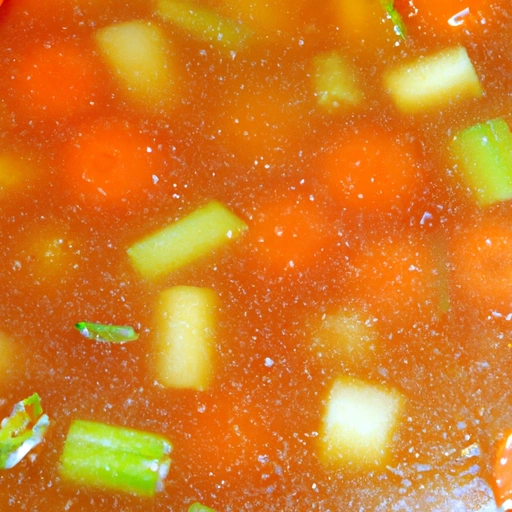Veggie Stock
Description

Veggie stock is a flavorful liquid made by simmering vegetables, herbs, and sometimes spices in water. This versatile ingredient is a staple in many cuisines, offering a rich base for soups, sauces, and other dishes. Veggie stock is typically made using onions, carrots, celery, garlic, and can include a variety of other vegetables, such as tomatoes, leeks, and mushrooms. It's a vegetarian alternative to meat-based stocks and broths, providing a depth of flavor while keeping dishes plant-based.
Common uses
Veggie stock is commonly used as a base for soups, stews, risottos, and sauces. It's also employed to add flavor to grains like rice, quinoa, and couscous when cooking them. In some recipes, veggie stock is used for braising vegetables or legumes, enhancing their natural flavors.
Nutritional value
Calories
Calories in veggie stock can vary based on the ingredients used but are typically low, making it a great option for calorie-conscious cooking. A cup of homemade veggie stock may contain between 15 to 40 calories (63 to 168 kJ).
Protein
Protein content in veggie stock is generally low, with an average of 0.5 to 2 grams per cup (240 milliliters).
Fat
Veggie stock contains minimal fat, often less than 1 gram per cup (240 milliliters), unless additional oil or butter is used in the preparation.
Carbohydrates
Carbohydrates in veggie stock are typically between 2 to 4 grams per cup (240 milliliters), mostly coming from the vegetables used in its creation.
Vitamins
Depending on the vegetables used, veggie stock can be a source of vitamins such as vitamin A from carrots, vitamin C from tomatoes, and various B vitamins.
Minerals
Minerals such as potassium, magnesium, and calcium can be present in veggie stock, especially if leafy greens or root vegetables are included in the recipe.
Health benefits
Consuming veggie stock can contribute to hydration due to its high water content while also providing essential nutrients from the vegetables used. It's a low-calorie and low-fat option suitable for many diets.
Potential risks
Store-bought veggie stocks can sometimes contain high levels of sodium or additives. It is advisable to check labels or make homemade stock to control these levels.
Common recipes
Veggie stock is a foundation for many recipes such as vegetarian soups like minestrone, lentil stew, or creamy vegetable soups. It's also used in gravies and vegan sauces.
Cooking methods
Veggie stock can be used in boiling, simmering, sautéing, and braising, among other cooking methods. It adds moisture and flavor to a wide range of dishes.
Pairing with other ingredients
It pairs well with earthy herbs such as thyme, rosemary, and bay leaves, as well as aromatic spices like peppercorns, cloves, and star anise.
Summary
Veggie stock is a nourishing and flavor-enhancing ingredient that adds depth to dishes without overpowering them. Its versatility and health benefits make it a popular choice in kitchens worldwide. Whether you're making a hearty vegetable soup or a delicate sauce, veggie stock is a component that brings out the best in your ingredients.